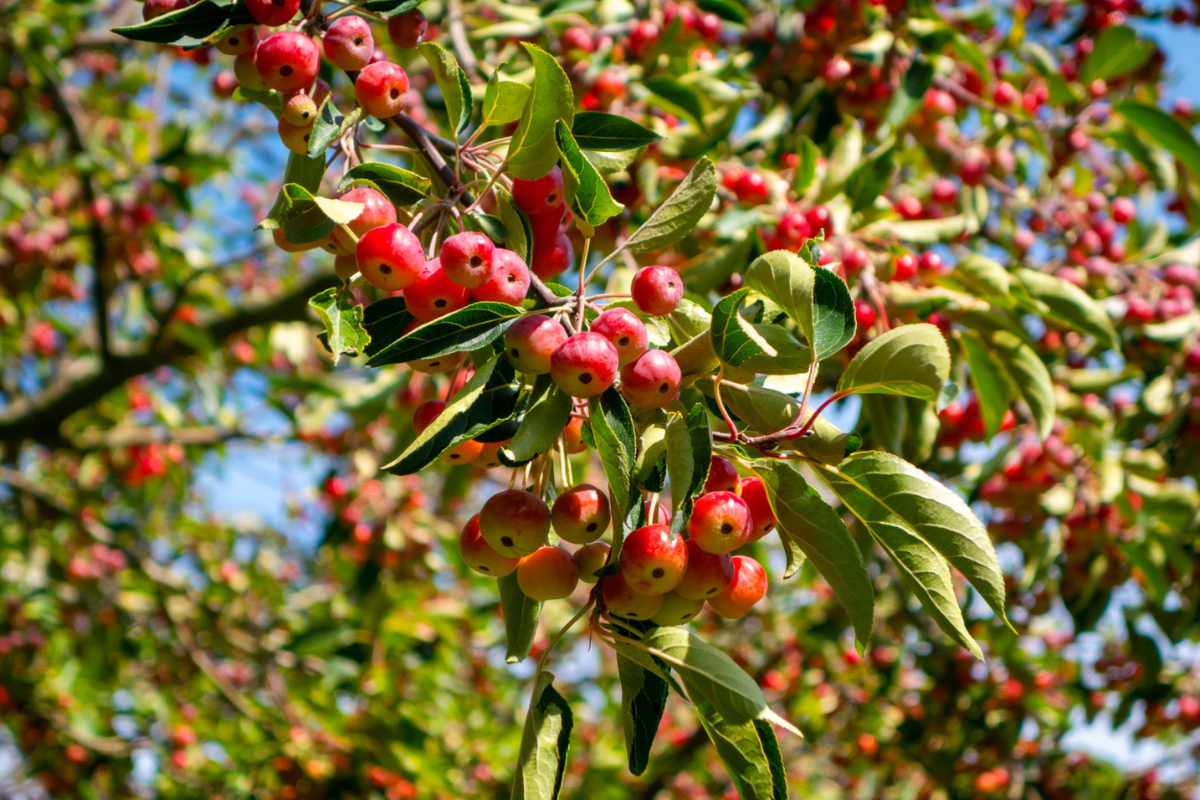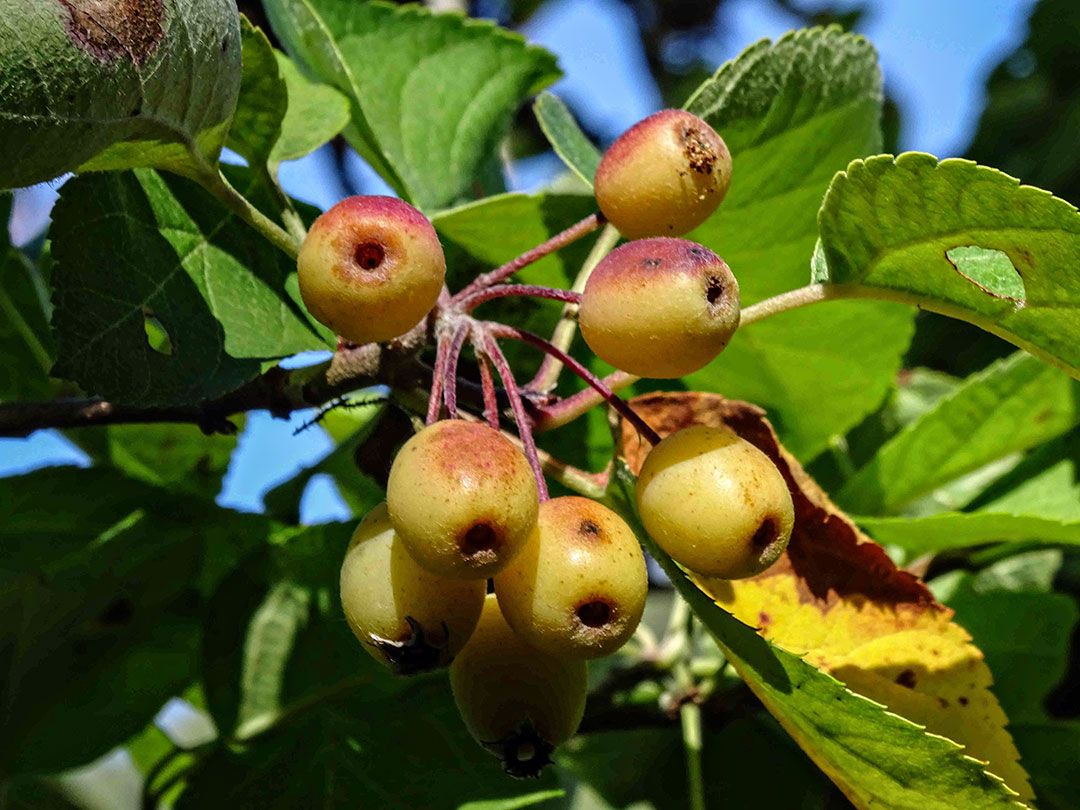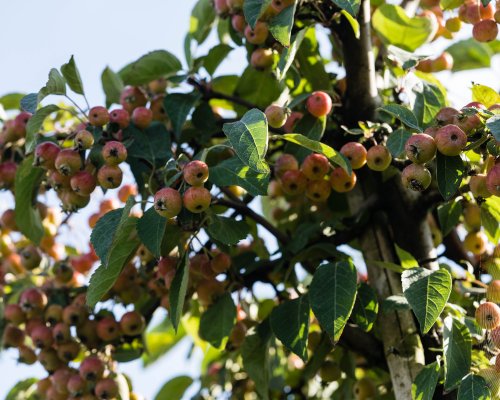Are Crabapples Poisonous to Dogs? What You Need To Know!
Are Crabapples Poisonous to Dogs? What You Need To Know!

Vet Reviewed

By: Sarah Hodgson
June 10, 2023
- Posted in Dogs
Table of Contents
As the saying goes "an apple a day keeps the doctor away". But did you know that there are many types of apples all over the world? One of those is a Crabapple, are they safe for dogs? While these small, tart apples may seem harmless, they can pose risks for our dogs.
In this article, we will explore the potential dangers of Crabapples for dogs, how to prevent poisoning, and the signs and symptoms to watch out for.
Let's dive in!
What Are Crabapples?
Crabapples are a smaller version of the standard apple, we all know and love. They are tiny fruits that grow on trees and resemble bigger apples. They come in various varieties, with some being edible for humans, while others are purely ornamental. You may have encountered them in orchards, as well as in decor that features dried blossoms or fruits on branches in vases or wreaths.

Are Crabapples Poisonous to Dogs?
Unfortunately, dogs and crabapples don't go together.
Yes, the stems and seeds contain small amounts of cyanide. While it won't one apple most likely won't kill a dog it is indeed toxic to them and can cause many health issues.
The actual flesh of crabapples is generally safe for dogs to eat in small amounts. The stems, seeds, and leaves contain a chemical called amygdalin. This chemical can release cyanide into the body when ingested, potentially leading to cyanide poisoning in dogs.
Cyanide In Dogs
Cyanide poisoning in dogs is a serious concern that can result from the ingestion of certain substances containing Cyanide compounds.
These compounds release cyanide when metabolized, posing a risk to a dog's health. Common sources of cyanide in dogs include specific plants, seeds, and chemicals. The same goes for crabapples as they contain small amounts of cyanogenic compounds, as do the seeds.
Cyanide toxicity can be deadly in only a few minutes for dogs. It is extremely toxic and should be avoided at all costs.
Long Term Effects of Crabapple Toxicity
While most cases of crabapple toxicity in dogs can be successfully treated, there may be potential long-term effects to consider. The severity of the toxicity and the duration of exposure can contribute to the extent of these effects.
In some cases, dogs may experience gastrointestinal issues such as chronic diarrhea or recurring stomach upset. This can be managed through dietary adjustments and medications prescribed by your veterinarian.
There is also a possibility of liver or kidney damage, especially if the toxicity is severe or if the dog has underlying health conditions. Regular monitoring of liver and kidney function through blood tests may be necessary to catch any potential complications early on.
Can Dogs Eat Crabapple Flesh?
We know now that the seeds and stems of crabapples contain cyanide which is toxic to them but what about the actual flesh can they eat that?
Yes, you can serve the flesh of crabapples to dogs, but it's important to do so with caution and in moderation.
There are proper ways to serve them which we will dive into now.
How To Properly Serve Crabapples to Your Dog?
Before you decide to share crab apples with your dog, it is important to understand how to serve them in a safe and appropriate way.
- Firstly, always make sure to wash the crab apples thoroughly to remove any dirt or pesticides that may be present on the skin. It is best to opt for organic crab apples to minimize the risk of exposing your dog to harmful chemicals.
- Next, remove the core and seeds of the crab apple before offering it to your dog. The seeds contain small amounts of cyanide, which can be toxic if ingested in large quantities. By removing the core and seeds, you can ensure that your dog only enjoys the flesh of the fruit, which is safe for consumption.
- Lastly, it is important to serve the crab apples in moderation. While they can be a healthy and tasty treat for your dog, too much of anything can cause digestive issues. Limit the amount of crab apples you give to your dog and monitor their reaction. If you notice any signs of discomfort or gastrointestinal upset, it is best to consult with your veterinarian.
In most cases, it's best to avoid crabapples as a whole just to ensure the safety of your dog.
Signs and Symptoms of Crabapple Poisoning in Dogs
If your dog ingests the toxic parts of the crabapple, such as the seeds, stems, or leaves, they may exhibit minor signs of cyanide poisoning.
Some common symptoms to watch out for include:
- Panting: Excessive panting may be an early sign of crabapple toxicity in dogs, indicating discomfort or distress.
- Dilated Pupils: Crabapple toxicity can lead to dilated pupils, suggesting potential neurological and systemic effects.
- Red Lips, Gums, or Tongue: The presence of redness in the lips, gums, or tongue may indicate cyanide exposure from crabapple seeds, requiring prompt attention.
- Diarrhea: Diarrhea can be a gastrointestinal response to crabapple toxicity in dogs and may contribute to dehydration.
- Vomiting: Vomiting is a common symptom of ingesting toxic substances, including crabapple seeds, and should be addressed promptly.
- Decrease in Heart Rate and Oxygen Levels: A decrease in heart rate and oxygen levels may signify severe poisoning, requiring immediate veterinary intervention in cases of crabapple toxicity.
- Seizures: Seizures can be a critical symptom of advanced crabapple toxicity, necessitating urgent veterinary care to address neurological complications.
Note
If you notice any of these symptoms in your dog after they have eaten crabapples or parts of the tree, seek veterinary assistance immediately.

What To Do If Your Dog Eats Crabapples
If you suspect your dog has consumed crabapple seeds, stems, or leaves or If your dog exhibits symptoms of crabapple toxicity, prompt veterinary care is crucial. Your veterinarian will assess the severity of the situation and provide appropriate treatment options.
In cases where the toxicity is mild, your veterinarian may induce vomiting to remove any remaining crab apple from your dog's stomach. They may also administer activated charcoal to help absorb any toxins that may still be present in the digestive tract.
For more severe cases, your dog may require intravenous fluids to maintain hydration and support kidney function. Additional medications may be prescribed to alleviate symptoms such as nausea and abdominal pain.
It is important to follow your veterinarian's instructions closely and provide any necessary follow-up care. Monitor your dog's progress and report any changes or concerns to your veterinarian.
Preventing Crab Apple Poisoning in Dogs
As with any food, you can always prevent your dog from going anywhere near it so nothing happens in the future. When it comes to crabapples prevention is much better than the cure. Ensuring that your dog doesn't eat any is the best way to go about this.
- Fence Off the Area: If you have crabapple trees in your yard, consider fencing off the area to prevent your dog from accessing the fallen fruit and leaves.
- Remove Fallen Fruit and Leaves: Regularly rake up and remove any fallen fruit or leaves from the area, especially during autumn when the concentration of amygdalin is highest.
- Monitor Your Dog: Keep a close eye on your dog when they are outside, especially if they are prone to eating things they find on the ground.
- Train Your Dog: Train your dog to avoid eating anything they find on the ground, reinforcing this behavior with positive reinforcement and treats.
- Educate Yourself: Learn to identify crab apple trees and the specific signs of amygdalin-containing parts, such as seeds and leaves, to better prevent accidental ingestion by your dog.
- Safe Alternatives: Consider planting dog-friendly vegetation or creating a designated play area in your yard where your dog can safely roam without exposure to potentially toxic plants.
- Use Pet-Friendly Fertilizers: Be cautious about the fertilizers and chemicals used in your garden. Choose pet-friendly options to minimize the risk of toxicity in case your dog comes into contact with treated soil.
The Bottom Line
So there you have it, Crabapples can pose a serious risk to dogs due to the presence of amygdalin in the seeds, stems, and leaves.
Even though, the flesh of the fruit isn't toxic and can provide some health benefits when consumed in moderation. The entire fruit should be avoided as a whole. If you suspect your dog has ingested toxic parts of the crab apple tree, seek veterinary assistance immediately.
Remember in the end our dogs rely on us so it's our responsibility to keep them safe at all times. Stay safe!

Subscribe to Petfluence!
Get updates on the latest posts and more from Petfluence straight to your inbox.